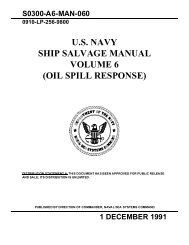FACEPLATE FNL (April 2004) - Supervisor of Salvage and Diving
FACEPLATE FNL (April 2004) - Supervisor of Salvage and Diving
FACEPLATE FNL (April 2004) - Supervisor of Salvage and Diving
Create successful ePaper yourself
Turn your PDF publications into a flip-book with our unique Google optimized e-Paper software.
On September 19, 2000, Secretary <strong>of</strong> the<br />
Navy Richard Danzig announced the<br />
forty-second Arleigh Burke Class Guided<br />
Missile Destroyer (DDG 92) would be<br />
named MOMSEN, in honor <strong>of</strong> Vice<br />
Admiral Charles Bowers Momsen.<br />
Momsen’s Naval career was highlighted<br />
by several technological achievements <strong>and</strong><br />
an unyielding determination to improve<br />
the safety <strong>and</strong> survival <strong>of</strong> Navy Divers<br />
<strong>and</strong> submariners. A pioneer <strong>of</strong> early<br />
diving <strong>and</strong> salvage equipment, a leader<br />
among the submarine community, <strong>and</strong> a<br />
visionary <strong>of</strong> future submarine design, it<br />
was fitting to name one <strong>of</strong> the nation’s<br />
most complex <strong>and</strong> technologically<br />
advanced warships in his honor.<br />
The keel was laid for MOMSEN on<br />
November 16, 2001, at Bath Iron Works in<br />
Bath, Maine. The Keel Laying Ceremony<br />
was the first <strong>of</strong> five ceremonies that would<br />
mark the progress <strong>of</strong> the ship’s<br />
construction. At that time, the ship was<br />
referred to as “Hull 475.” The name<br />
MOMSEN would come later. In recent<br />
years, BIW invested in the most advanced<br />
shipbuilding process <strong>and</strong> built a L<strong>and</strong> Level<br />
Transfer Facility. Ships are no longer built<br />
on an inclined ways <strong>and</strong> slid into the<br />
Kennebec River. Instead, large segments<br />
<strong>of</strong> hull are assembled inside buildings <strong>and</strong><br />
then maneuvered on rails <strong>and</strong> craned into<br />
position on the shipway. A ship is<br />
assembled entirely on level l<strong>and</strong> <strong>and</strong> is put<br />
into the water only when a desired level <strong>of</strong><br />
completion is achieved. This production<br />
MOMSEN Keel Laying Ceremony.<br />
technique is more efficient <strong>and</strong> MOMSEN<br />
is the second Bath-built ship from this new<br />
facility.<br />
As Charles Momsen challenged<br />
twentieth-century technological barriers<br />
<strong>and</strong> introduced revolutionary equipment,<br />
the twenty-first century MOMSEN<br />
introduces some <strong>of</strong> the Navy’s most<br />
advanced surface combatant technology<br />
<strong>and</strong> design. MOMSEN is a ship <strong>of</strong> firsts<br />
for Bath Iron Works - the first vessel with a<br />
completely commercial grade 60hz power<br />
distribution system <strong>and</strong> the first Baseline 7<br />
Phase 1 AEGIS weapon system that runs<br />
entirely on commercial computers. There<br />
is not a single military specification<br />
(MILSPEC) computer on the entire ship.<br />
MOMSEN is equipped with the SPY-1D(V)<br />
three-dimensional phased array radar that<br />
is a generational leap in capability over<br />
previous SPY radars in the Fleet. Finally,<br />
MOMSEN is built with the Remote<br />
Minehunting System (RMS), the surface<br />
Navy’s first organic mine warfare systems<br />
to reach fleet production. RMS is a long<br />
range, over-the-horizon, semi-submersible<br />
system capable <strong>of</strong> detecting, identifying,<br />
<strong>and</strong> relaying the location <strong>of</strong> underwater<br />
mines.<br />
LT Brad Stallings, the Chief Engineer<br />
<strong>and</strong> first MOMSEN crewmember, reported<br />
to the Pre-Commissioning Unit in Bath,<br />
Maine during the summer <strong>of</strong> 2002. “Hull<br />
475” was 61% complete <strong>and</strong> the shipyard<br />
was focused on completing the construction<br />
<strong>of</strong> the segments that would<br />
ultimately be assembled into a<br />
complete hull. The priority for LT<br />
Stallings was starting the long<br />
complex task <strong>of</strong> establishing a<br />
comm<strong>and</strong> organization <strong>and</strong><br />
administrative architecture.<br />
Assisted by a superb Northrop<br />
Grumman Pre-Commissioning<br />
support staff, he “laid the keel”<br />
for Pre-Commissioning Unit<br />
MOMSEN, or more commonly<br />
referred to as the PCU. PCU<br />
MOMSEN was the name <strong>of</strong> the<br />
comm<strong>and</strong> the crew belonged to<br />
until the date when the Navy<br />
L<strong>and</strong> Level Ship Construction.<br />
<strong>of</strong>ficially accepted the ship. Crewmembers<br />
arrived in four phases throughout the Pre-<br />
Commissioning process. Phase One was<br />
the first 15 crewmembers <strong>and</strong> the core <strong>of</strong><br />
senior <strong>of</strong>ficer <strong>and</strong> enlisted expertise, who<br />
established the priorities that guided the<br />
organization through the remaining phases.<br />
Phases Two <strong>and</strong> Three filled out the<br />
organization with mid-grade <strong>of</strong>ficers <strong>and</strong><br />
enlisted, allowing divisions <strong>and</strong> work<br />
centers to be formed. PCU MOMSEN’s<br />
Phase Three was completed in December<br />
<strong>of</strong> 2003 with just under 100 crewmembers<br />
on site in Bath. Phase Four, the largest <strong>of</strong><br />
all phases, was the addition <strong>of</strong> the most<br />
junior crewmembers, those that had<br />
recently graduated from Recruit Training<br />
Center <strong>and</strong> follow-on schools. Phase Four<br />
was completed in May <strong>of</strong> <strong>2004</strong> with<br />
MOMSEN’s crew just short <strong>of</strong> three<br />
hundred personnel. By the time the ship<br />
leaves the shipyard <strong>and</strong> is augmented by<br />
an SH-60 helicopter detachment, the crew<br />
size will be 350 personnel.<br />
MOMSEN crewmembers first reported<br />
to PCU MOMSEN’s Training Detachment<br />
in San Diego, California. Under the<br />
supervision <strong>of</strong> the MOMSEN’s Comm<strong>and</strong><br />
Master Chief, CMDCM(SW)(AW) Mark<br />
Baker, they attended rate or job specific<br />
schools before reporting to the Pre-<br />
1 0 A u g u s t 2 0 0 4

















